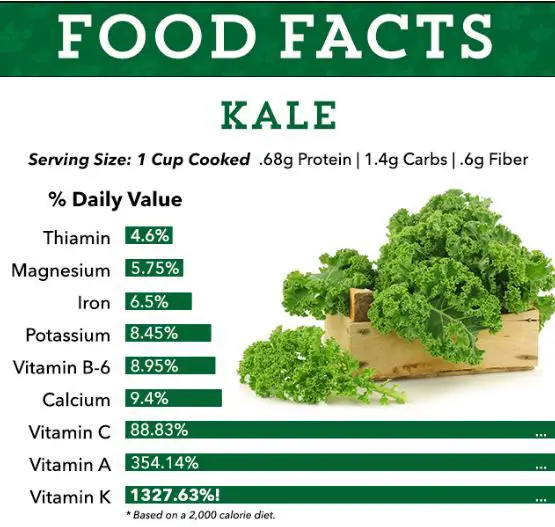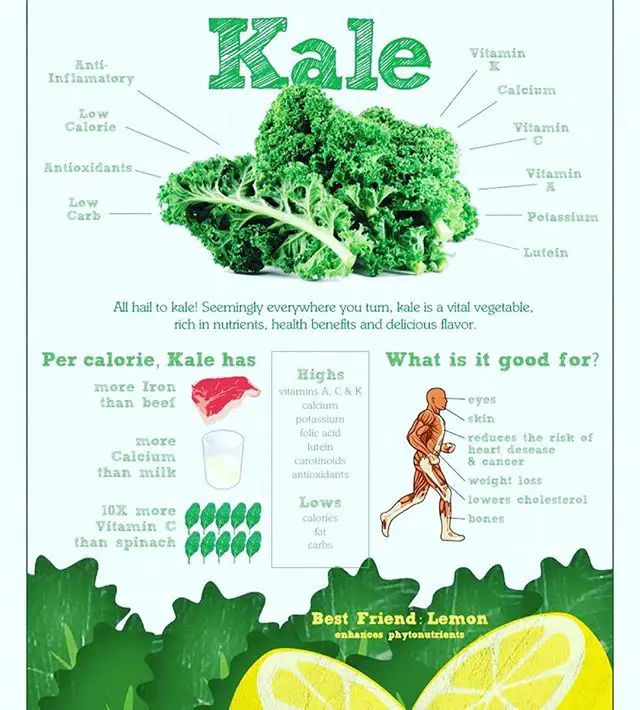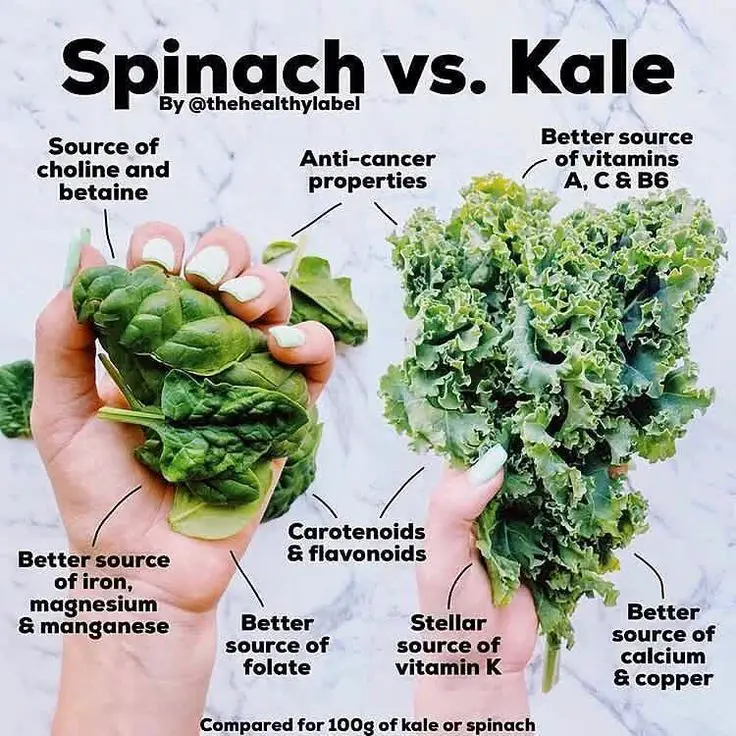Kale Is Good For Skin And Hair Care
For those looking to get clearer skin, sulfur helps remove toxins from the skin, scar reduction, and collagen production.
Beta-carotene, the carotenoid that is found in high amounts in kale, is converted by the body into vitamin A as needed .
A cup of cooked kale provides 885 mcg of retinol A equivalent, the nutrient essential for the growth of all bodily tissues, including hair and skin, as well as for the production of sebum, the oil which helps keep hair and skin moisturized.
Eyesight and reproductive and immune function also rely on vitamin A.
A cup of cooked kale provides 53.3 mg of vitamin C, which is needed to build and maintain collagen, the key protein that keeps skin looking youthful and aids in wound healing .
Also, vitamin C supports iron absorption.
Kale is rich in both vitamin C and iron , which could help prevent hair loss associated with iron deficiency .
Though iron supplements should not be taken unless patients have anemia, natural sources of iron, such as kale, may help maintain hair.
How To Make: Kale Chips
Kale Is High In Calcium
Per calorie, kale has more calcium than milk. Calcium is a mineral thats important for building and maintaining strong bones and for carrying out a large number of body processes such as cell signaling involved in muscle and nerve function and helping blood vessels transport blood through the body,explainsJess Cording, R.D.
Read Also: Is Ascorbic Acid Real Vitamin C
Is Kale Healthier Than Spinach
Choosing between leafy greens is like Sophies Choice for dietitians. Each has their own long list of benefits. Spinach is higher in magnesium, iron, and folate, which are important for muscle and tissue health. On the flip side, kale is higher in calcium, plant-based proteins, and vitamin C not to mention those carotenoids.
FYI: Kale contains high amounts of vitamin K, so take note if you’re on a blood thinner.
What do these slight differences between greens mean for you? Eat more of both and mix it up often.
Any Interesting Facts About Kale

- Most of the kale in the United States is produced in California.
- In Spanish, kale is called col rizada.
- Cooking kale doesnt destroy any of its nutrients.
- Kale farming grew by a staggering 57% from 2007 to 2012.
- Hollywood celebrities like Angelina Jolie, Katy Perry, and Jessica Alba are known to consume kale not just to feel better but also to maintain their sleek physiques.
- After frost, the kale plant becomes sweeter.
- Thomas Jefferson is believed to have experimented with several varieties of kale in his garden way back in the early 1800s.
Thats with the facts. Now lets talk about what we are here for the benefits of kale.
You May Like: Best Vitamins For Anti Aging
How To Enjoy Kale
Kale has a sturdy texture which makes it a good addition to soups and stews. It also can be sautéed, steamed or baked. It can even be eaten raw. In general, the smaller, younger leaves are more tender.
Here are some ideas for how to use kale:
- Sauté kale with some olive oil, shallots, garlic, and a pinch of red pepper flakes- finish with a squeeze of lemon or balsamic vinegar
- Add it to your stir fries instead of broccoli- it tastes great with Asian flavors like ginger, garlic and soy sauce
- Mix up your salad greens- try using raw kale in your next salad instead of lettuce or spinach
- Blend raw kale with bananas, apples or other fruits and vegetables for a tasty and nutritious smoothie
- Stir chopped kale into soups and stews, lentils, and chili
- Add it to your pasta dishes
- Braise kale with apples and a dash of cider vinegar
- Add sautéed kale to your omelettes, frittatas, pasta or pizza
- Bake kale leaves in the oven for a crispy, healthy snack
Storage And Food Safety
You can store kale in the coldest part of your refrigerator for a few days. To prevent wilting, place it in a plastic bag first and close it loosely. If you are unable to use it in a few days, cook it and place it back in the refrigerator cooked.
Freeze your kale if you don’t plan on using it for a while. It will keep in the freezer for about a month or two.
Always be sure to wash kale before using it because the large curly leaves often catch dirt. To wash fresh kale, place it in a bowl of cold water and swish it around. Empty the bowl and repeat until all the dirt is cleared from the leaves.
Read Also: How Much Iron Is In Prenatal Vitamins
Kale Vs Spinach: Whats The Difference And Which Is Better For You
Are you someone who prefers spinach to kale? The good news is that both veggies can have a positive impact on your health.
You can include both on your plate or alternate between the two for variety. But if youre curious as to whether one is better than the other, heres how these two veggies stack up.
What Are The Different Types Of Kale
One benefit of kale is that you can choose from a variety of types. For example:
Curly Kale This is the most common type of kale, and you can recognize it by its curly or ruffled edges. Its available in different colors, including purple, dark green, and bright green.
Red Kale Red kale has a slightly different appearance from curly kale. Its leaves may appear deep red or grayish green.
Lacinato/Dinosaur Kale This type of kale has a deeper color, with leaves that are a dark bluish-green. This type of kale is more tender than curly or red kale, making it easier to eat raw.
Baby Kale With its young tender leaves, this kale is also a good choice for a raw, healthy snack.
Purple Flowering Kale This kale has a bitter taste and closely resembles cabbage leaves.
White Flowering Kale Add this kale to the menu if you prefer a peppery taste in your soups and side dishes.
Recommended Reading: How Much Is 50000 Units Of Vitamin D
Is Kale Safe For Everyone To Eat
As kale is a rich source of vitamin K, those on anti-coagulant medication need to consider the amount they eat. Typically the advice while on this medication is that you should aim to keep your dietary intake approximately the same. Check with your GP before making any significant dietary changes.
Some people with thyroid issues or those on thyroid medication should be mindful about consuming cruciferous vegetables like kale. This is because they may affect the thyroids ability to absorb iodine. That said, kale is of lower risk because of its low levels of these goitrogenic compounds.
If you are concerned or have queries, please consult your GP or registered dietician for guidance.
Improves Skin Health And Appearance
This vegetable doesnt only improve your waistline and help reduce the risk of certain illnesses, it can also improve your skin.
Vitamin A is essential for healthy cell growth, and a vitamin A deficiency often leads to dry skin and acne.
Although vitamin A is measured in IU, it has micrograms of retinol activity equivalents . The recommended daily amount of RAE is 900 mcg for adult men and 700 mcg for adult women. One cup of cooked kale contains the equivalent of 172 mcg of RAE of vitamin A.
Read Also: Does Vitamin D Help With Stress
Kale Is Packed With Antioxidants
Kale, like other leafy green vegetables, is very rich in antioxidants, including vitamin C, beta-carotene, as well as various flavonoids and polyphenols .
Simply put, antioxidants counteract oxidative damage by free radicals in the body .
Oxidative damage is thought to be among the leading causes of aging and many other diseases, including cancer , but many substances that are antioxidants also have other important functions.
Some of these important antioxidants are the flavonoids quercetin and kaempferol, which are found in relatively large amounts in kale .
These substances have been studied intensely and have powerful anti-inflammatory, antiviral, anticancer, antidepressant, cardioprotective, and blood pressure lowering effects .
It Helps You Eat Your 5 Portions Of Fruits And Vegetables

Kale is a food that makes it very easy to improve your eating habits and start increasing your consumption of vegetables in the diet.
A diet that, currently in the West, is full of ultra-processed foods with little nutritional diversity and high energy value, one of the causes of the increase in obesity.
You can make juices with kale for the whole family, including your children, helping them get used to consuming vegetables in their day to day a nutritional education practice that theyll appreciate in the future.
Don’t Miss: Where Are Shaklee Vitamins Made
When Is Kale In Season
Kale thrives in cold temperatures, so peak wintertime is the ideal season to stock on this veg, Glass says. Many farmers will leave kale in the ground all winter and just harvest as needed, making it super fresh at your local farmers market, she adds.
Though it can grow year-round, cooler months tend to yield a sweeter, more flavorful leaf. Similar to Swiss chard, carrots, spinach, parsnips, and other cold-weather vegetables, as temperatures drop, the plant will replace water with sugar because it helps prevent freezing, Tse explains. This is why winter vegetables tend to get sweeter after a cold frost.
Just be sure to look for leaves that are stiff, not wilted, and appear in good shape, suggests Moser. Glass adds youll want to check the coloring of the kale and avoid any leaves that are yellowing. Some holes in the leaves are totally fine, as kale is particularly susceptible to pests, Tse says.
It Is An Excellent Source Of Vitamin C
Vitamin C is an important water-soluble antioxidant that serves many vital functions in the bodys cells.
For example, it is necessary for the synthesis of collagen, the most abundant structural protein in the body.
Kale is much higher in vitamin C than most other vegetables, containing about 4.5 times much as spinach .
The truth is, kale is actually one of the worlds best sources of vitamin C. A cup of raw kale contains even more vitamin C than a whole orange .
Summary
Kale is extremely high in vitamin C, an antioxidant that has many important roles in the body. A single cup of raw kale actually contains more vitamin C than an orange.
Read Also: When To Take Vitamin C And Zinc
It’s A Great Source Of Vitamin K
Vitamin K isn’t always easy to come by, especially if you don’t eat meat. But “kale, collard greens, and Swiss chard are some of the highest sources of the plant version of vitamin K,” says Stefanski.
Getting enough vitamin K helps with blood clotting, which aids your body in healing from wounds.
Vitamin K deficiencies have also been linked to a higher risk of bone fractures. A 2009 study found that vitamin K reduced the risk of bone fractures in postmenopausal women. This is particularly important since postmenopausal women are at a higher risk of bone loss.
Your body absorbs vitamin K more easily when you eat it along with a healthy fat or oil, so it may help to eat kale with an oily salad dressing or sautée it in light oil.
One cup of cooked kale offers 544 micrograms of vitamin K, which gives you 453% of your daily value. Eating a large amount of vitamin K in foods isn’t harmful to your body vitamin K is only dangerous when you take too many synthetic supplements.
Allergies Due To Kale Chips
Kale is among the most nutritious and healthy foods available. Similar to this, kale chips are famous nutritious snacks used nowadays. These are rich in macros like protein, fats, and fibres and contain many calories.
Regarding micronutrients, kale chips are rich in vitamins, minerals and antioxidants. For most kale consumers, it is safe and does not cause any potential side effects. However, in very few cases, kale may be allergic.
Kale is a cruciferous vegetable. So, people with a cruciferous vegetable allergy must avoid their consumption. Kale can also cause bloating in some people and difficulty in digestion. Few people also experienced gastrointestinal distress from cruciferous vegetables.
People who eat kale or kale chips often and have an allergy to cruciferous vegetables are at high risk of developing kale allergies. Let us discuss some symptoms you may observe if you have a kale allergy.
Read Also: What Are The Top Vitamins To Take
The Many Types And Health Benefits Of Kale
Topics in this Post
Kale is not a new vegetable, but you may have just started hearing more about it. Its popular in northern Europe and now throughout the U.S. During the Middle Ages, kale was planted and used to feed humans and livestock. History books state that Thomas Jefferson experimented with several varieties of kale at his Monticello estate in the early 1800s.
The popularity of kale has skyrocketed in our country over the last four to five years. It has become available at not only farmers markets but local grocery stores, as well. You can purchase it in fresh bunches or prerinsed and trimmed in bags. Local gardeners are also planting kale for their own use on the dinner table.
TYPES OF KALE
- Curly kale is the most common type. The bright green leaves look like ruffles. The flavor is pungent and peppery.
- Dinosaur kale has narrow green leaves that are wrinkly like dinosaur skin. The leaves are attached to a firm stem that should be removed.
- Redbor kale is kale with ruffled leaves ranging in color from a deep red to purple.
- Russian kale is harder to find and it has flat fringed leaves that range in color from green to red to purple. It has a more sweet and peppery flavor.
NUTRITIONAL BENEFITS
USES FOR KALE
Kale is a cool-weather and frost-resistant plant and is available in Minnesota January through June and October through December.
KALE CHALLENGE
TRY A RECIPE WITH KALE
Braised kale with cherry tomatoes
Ingredients
Directions
Kale Benefits : Lowers Cholesterol
Research has found kale could increase good and decrease bad cholesterols, with one study reporting a 27% rise in the former and a 10% drop in the latter after drinking kale juice for 12 weeks.
But remember: it’s always better to access the many kale benefits by eating the leaves in their whole form, rather than juicing.
When you juice vegetables and fruit you strip away their highly beneficial fibre content, which – among other health wins – is crucial for supporting good gut health. And we don’t need to tell you just how important good gut health is for your overall health – mind and body.
Recommended Reading: What’s The Most Important Vitamin
Do I Have To Eat Kale Raw
ALL ABOUT KALE
Nope! In fact, recent research found eating both cooked and raw kale can help you reap the best benefits of Brassica veggies. The bottom line still holds: More is more when it comes to kale. Lightly sautéing the leaves in plant-based oils like avocado or canola may help to make an otherwise bitter-tasting veggie more palatable.
The only way Id recommend you dont have your kale? In juice, which strips out fiber and other nutritional qualities. If the bottle doesn’t have more than 100% of your daily value of vitamins A and C, you’re likely overpaying for this iteration of greens.
Whats In Kale A Look At The Veggies Nutritional Facts

Eating well is one way to feel and look healthier. Kale is an excellent choice, providing your body with many nutrients, minerals, and vitamins, according to the U.S. Department of Agricultures MyPlate guidelines.
One cup of cooked kale has about 42 calories, 106 grams of water, and 1.4 g of fat. Other nutritional facts for kale include:
- 172 retinol activity equivalents of vitamin A
- 21 milligrams of vitamin C
- 493 micrograms of vitamin K
- 177 mg of calcium
- 30 mg of magnesium
- 170 mg of potassium
You May Like: What Vitamins Can Help With Ed
If You Eat Kale Every Day You Could Boost Your Antioxidant Level
One of the super great things that eating kale every day can do for you is raise your antioxidant level naturally, and that has benefits for your body, as noted by registered dietitian Rachel Fine. Lutein and zeaxanthin are the most common antioxidants found in leafy greens like kale, she told The List. Antioxidants protect our cells against free radicals, which can damage human cells.
But do you have to eat kale raw in order to reap those benefits? As it turns out, no, according to Jaclyn London, a registered dietitian. In fact, recent research found eating both cooked and raw kale can help you reap the best benefits of Brassica veggies, she penned in an article in Good Housekeeping. The bottom line still holds: More is more when it comes to kale. She added that lightly sautéing kale in healthy oils like canola or avocado oil can reduce the bitter taste, making it a more pleasant dining experience. So, by all means, follow some of the best ways to cook kale and add in a little flavor to your meals if you want to eat kale every day try any of the ways to make kale less terrible. Luckily, it turns out there are quite a few recipes that use kale as a secret ingredient.